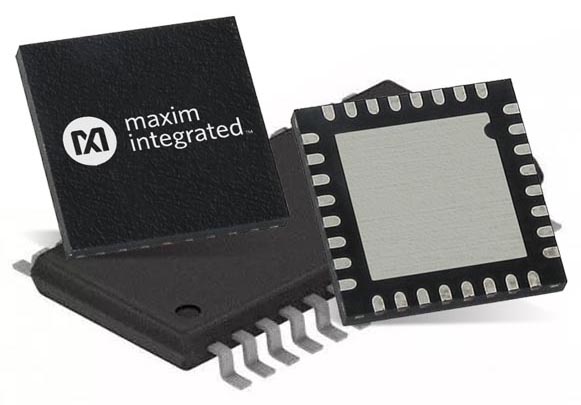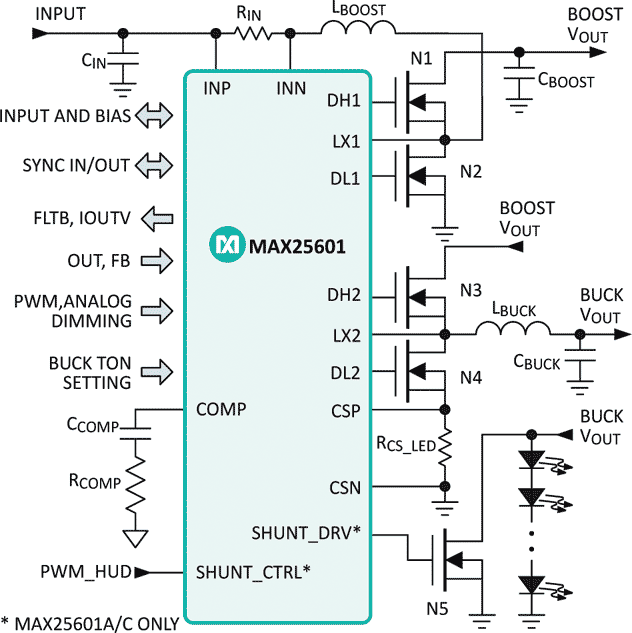Automotive synchronous boost controller with buck LED controller optimizes 2 stage LED lighting designs
Maxim Integrated Products has released a new family of automotive ICs. The MAX25601A/B/C/D is a synchronous boost controller followed by a synchronous buck LED controller. The 4.5 V to 40 V input voltage range of the boost controller is ideal for automotive applications, and acts as a pre-boost power supply for the second-stage buck LED controller.

The synchronous boost is a current-mode controller that can be paralleled with another device to provide higher output power. A SYNCOUT pin provides the clock to drive the RT/SYNCIN pin of the other device, enabling two-phase 180-degree out-of-phase operation. The boost converter can be programmed with a switching frequency of 200 kHz to 2.2 MHz. Spread spectrum is included to reduce EMI. An internal digital soft-start feature is provided to enable a smooth power up of the boost output. Protection features like hiccup mode, overvoltage protection, and thermal shutdown are provided.
The synchronous buck LED controller uses Maxim's F3 Architecture, a proprietary average-current-mode control scheme to regulate the inductor current at a constant switching frequency without any control-loop compensation. Inductor current is sensed in the bottom synchronous n-channel MOSFET. The device operates over a wide 4.5 V to 65 V input range at switching frequencies as high as 1 MHz. Both analog and PWM dimming are included. LED current can be monitored on the IOUTV pin.
Both controllers have high- and low-side gate drivers with at least 1 A peak source and sink-current capability. Adaptive non-overlap control logic prevents shoot-through currents during transition. Both the boost and the buck faults are monitored on the active-low FLT pin.
 |
| Simplified Application Circuit. |
The MAX25601A/C is available in a 32-pin SWTQFN package and the MAX25601B/D is available in a 28-pin TSSOP package. The 32-pin package features an additional switch control that can be used in high-beam/low-beam and heads-up display applications.
Key Features
- Integration Minimizes BOM for High-Brightness LED Driver, Saving Space and Cost
- Wide Input-Voltage Range from 4.5 V to 40 V
- Wide Boost-Output Range up to 65 V
- Programmable Switching Frequency Optimizes Component Size
- External MOSFETs Can be Sized for Appropriate Current
- Synchronous Rectification Provides High Efficiency and Fast Transient Response
- Average Current-Mode Control for Buck Eliminates Compensation Components
- Wide Dimming Ratio Allows High Contrast Ratio
- Analog Dimming and PWM Dimming
- Analog Voltage-Controlled PWM Dimming
- Protection Features and Wide Temperature Range Increase System Reliability
- Short Circuit, Overvoltage, and Thermal Protection
- –40 °C to +125 °C Operating Temperature Range
Applications
- Automotive Exterior Lighting:
- High-Beam/Low-Beam/ Signal/Position Lights,
- Daytime Running Lights (DRLs),
- Matrix Light,
- Pixel Light,
- Other Adaptive Front-Light Assemblies
- Commercial, Industrial, and Architectural Lighting
